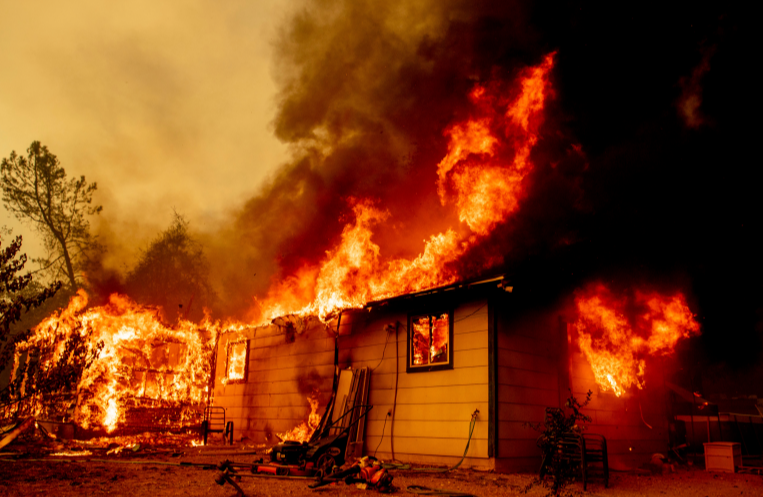
As the threat from wildfires to life and property has increased, so too has demand for services to protect against it [File: Ethan Swope/AP Photo]
Los Angeles, October 12 (RHC)-- In 2003, Joe Torres was deployed in Afghanistan with the United States Air Force as a firefighter, working crash and rescue, but it was a fire raging much closer to home at the time that would set his post-service life on its current trajectory.
Back then, the Cedar Fire in San Diego ranked as the largest in Californian history, reaching a total of more than 190,000 hectares (270,000 acres) and killing 15 people.
“When I started working as a firefighter, that was considered a huge fire,” Torres told Al Jazeera. “I was reading about this fire and thinking, ‘Wow, California is burning.’”
Fires of such magnitude were indeed seen as exceptional events nearly two decades ago, but the passage of time has intensified nature’s fury. Nine of California’s 20 largest wildfires on record have torn through the state since last year, according to Cal Fire. The biggest – the August Complex Fire of August 2020, consumed more than 404,000 hectares (one million acres) of land and killing one person.
As the threat from wildfires to life and property has increased, so too has demand for services to protect against it.
Torres has seen that boom first-hand. In 2014, he bought All Risk Shield, a firm focused on providing wildfire damage risk assessments for homes and businesses as well as advice on how to mitigate them.
For years, he was the firm’s sole employee – and a part-time one at that. “I felt a little deflated at times because it didn’t seem to be going anywhere,” said Torres.
But his business took off last year, when wildfires consumed millions of acres of land across the western United States, resulting in insured losses between $7bn and $13bn losses, according to risk management firm RMS.
“I brought on our first employee in June of 2020 and now we have around 20 employees throughout California,” said Torres. “These fires are a fact of life now and I think the demand for these services will continue to grow.”
All Risk Shield offers two risk assessment packages with prices starting between $1,550 and $2,250. The services involve surveying a property to identify factors such as thick vegetation that can make a home more vulnerable to ember ignition during a wildfire, as well as measures to make homes more fire-resistant.
Torres is not the only firefighter-turned-fire prevention service provider. Danny Glessner, a retired firefighter who worked the front lines for 35 years runs Wildfire Home Hardening Specialists. “Home hardening” includes measures such as installing ember-resistant fencing, gutter guards, and flame retardant to make a property more resilient.
Glessner travels throughout the western United States to inspect sites and offer consultations to clients ranging from vineyard owners to homeowners. “For residential properties, my services generally range from $500 to $1,500,” he said, adding that he charges more for large businesses such as wineries, equestrian and animal rescue shelters.
Currently, he is a one-man band, but he expects that to change. “I do see adding employees in the future,” Glessner told Al Jazeera. “The wildfire problem is not going away anytime soon and as long as home building and populations keep increasing in wildfire-prone areas, there will be plenty of room for us and other similar businesses.”
Even for veteran firefighters such as Glessner, who started his career in the early 1980s, the current scale of fire season is stunning. “The two largest fires in state history occurred this year and last year,” Glessner said. “When you look at the data, it’s kind of crazy.”
A number of factors help to explain the dramatic increase in large fires throughout California. Many of them, such as prolonged drought and hot weather, are being driven by climate change.
The problem has been compounded by years of fire management that have focused on suppressing flames as soon as they break out. That has contributed to the unregulated growth of thick vegetation that, combined with heat and dry weather, act as kindling once a fire ignites.
Frank Bigelow, a deputy chief at Cal Fire, California’s firefighting agency, said that preventive steps can make a substantial difference when it comes to a property’s likelihood of surviving a fire event.
Cal Fire does not track the number of businesses offering services related to wildfire property protection. But Bigelow said when owners take preventive steps, it can create safer conditions for firefighters.
“This is good for the safety of a property as well as the safety of firefighters,” Bigelow told Al Jazeera. “Any time an organisation is spreading information about the importance of creating defensible spaces, that’s a positive.”
“Defensible space” refers to a zone of around 30 metres (100 feet) around a property where homeowners can take steps such as removing dead and dry vegetation, keeping gutters and rooftops clear of leaves, and trimming shrubs and trees to maximise vertical and horizontal spacing.
The more space between vegetation, Bigelow explained, the more difficult it is for a fire to spread. Cal Fire has a full list of steps homeowners can take to prepare their properties (PDF).
Torres said that the risk is greatest in areas that straddle the boundary between residential spaces and wildland, known as wildland-urban interface.
Those areas include the forested areas in Lake Tahoe, the sprawling plains of Napa and Sonoma, and the arid hills that overlook the sparkling Pacific Ocean in Malibu and the Palisades – all areas where Torres said customers have sought his services.

